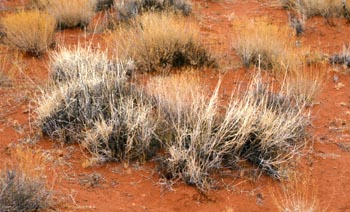Big Galleta

Common Name(s):
Big Galleta
Scientific Name:
Pleuralphis rigida Thurb.
Hilaria rigida (Thurb.) Benth. Ex Scribn.
Symbol:
PLRI3
Description:
Life Span: Perennial
Origin: Native
Season: Warm
Growth Characteristics: Big galleta is a native perennial grass. It is highly branched at the base, giving it a bush-like appearance. Big galleta's clumped growth form is a result of the tillers or short rhizomes it produces. Its root system tends to be shallow and extends radially from the base of the plant. Big galleta primarily reproduces by rhizomes, and most likely by tillering as well. Little information is available on germination characteristics of big galleta. Seed production is generally very poor and seedling establishment appears to be rare. Big galleta generally undergoes 2 major growth periods, coinciding with the typical bimodal rainfall patterns within its area of distribution. It also can complete its life cycle rapidly in response to periodic rains. Big galleta typically flowers from February through June in the Mohave Desert
Seedhead: Spike composed of groups of chaffy seed which drop at maturity to leave a zigzag seed stalk. Spikes are mostly 1 ½ to 4 inches long.
Leaves: Leaves are blue-green, coarse, nearly straight, and fairly wide. The edges are sometimes rolled. They are attached both at the base of the plant and along the upright stems that bear seedheads. The leaf blades may be partly covered with short, light wooly fuzz. The leaves form a dense clump that can be up to 3 feet tall by 4 feet wide.
Leaves: The coarse, rigid stem can either be erect or decumbent, and reach 12 to 40 inches (30-100 cm) in height.
Ecological Adaptions:
Big galleta is fast growing, long lived, and very drought tolerant. It is often found in deserts, on plains, sand dunes, and rocky hillsides up to an elevation of 4,000 feet. It is reported to be more effective than many other desert plants at extracting water from the soil during dry periods.
Big galleta's range extends from southern Utah, Colorado, and Nevada south through California and Arizona and into northern Mexico. In Utah, it is very common on the sand dunes in Washington and Kane counties.
Soils: Big galleta is found on dry, open, sandy to rocky slopes and flats, on sand dunes, and in bajadas, scrublands, woodlands, and desert areas. Big galleta occurs on all soil textures, but displays poor growth on clays.
Associated Species: creosotebush, white bursage, blackbrush, Joshua tree, yucca, range ratany, winterfat, brittle bush, ephedra, wolfberry, globemallow.
Uses and Management:
Big galleta is considered a valuable forage plant for cattle and domestic sheep in the Mohave Desert. Palatability for both livestock and wildlife ranges from fair to good, except being poor in palatability to Elk and Waterfowl. Its coarse, rigid culms make it relatively resistant to heavy grazing and trampling. The clumped growth form stabilizes blowing sand and it is used for revegetation and erosion control.

